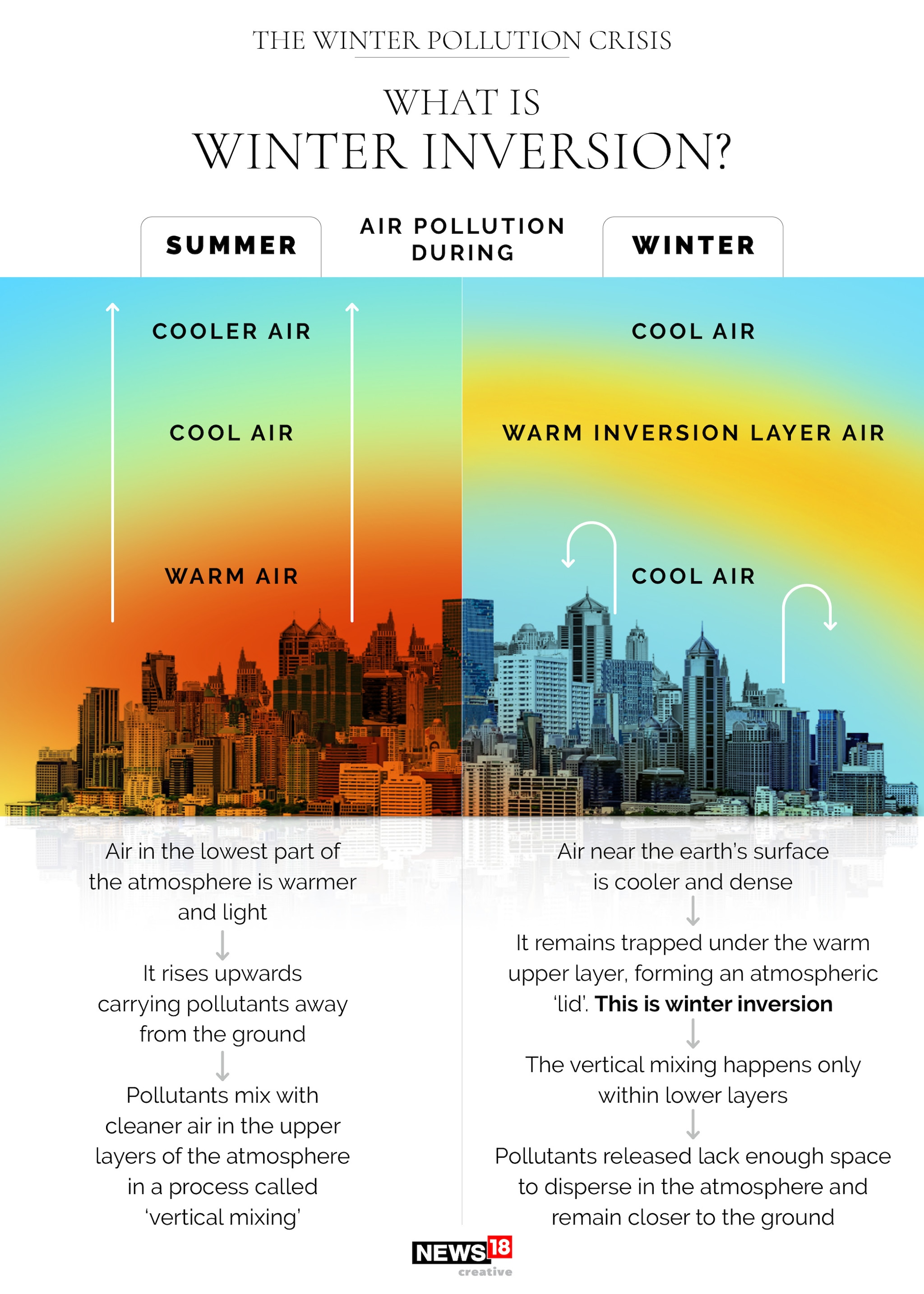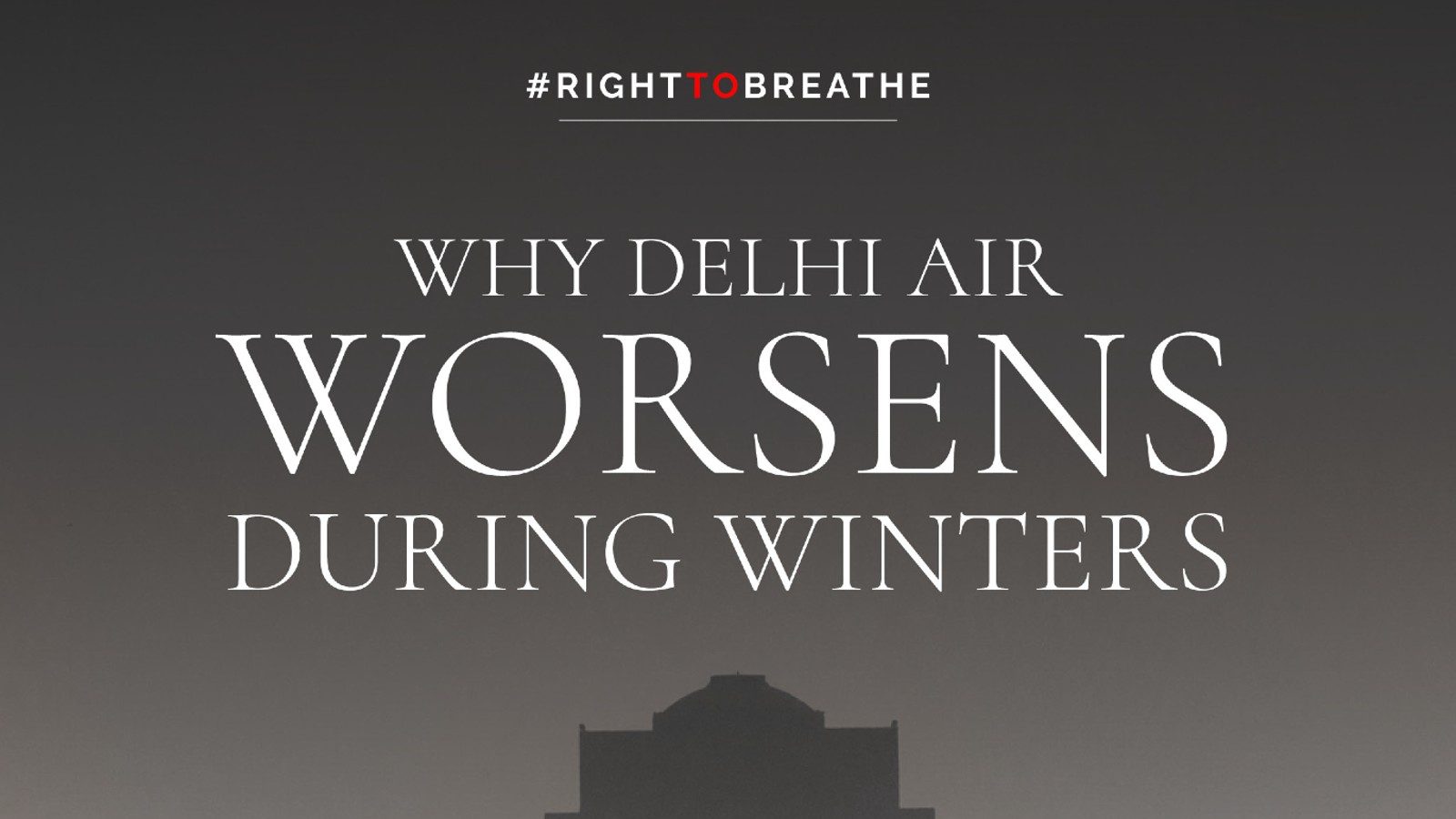The world has been confined to houses for the past two years. Everyday activities that could not be done without going outside immediately came indoors – from the office to grocery shopping and school. As the world embraces the new normal, News18 is launching weekly sessions for school children, explaining key chapters with examples from events around the world. While we try to simplify your threads, a request to break a thread can be sent in a tweet @news18dotcom.
Air pollution in Delhi is prevalent throughout the year. However, air pollution increases in the post-monsoon months due to a combination of atmospheric conditions and human factors. Once winter hits Delhi, the city can expect more than twice as much air pollution as in spring and summer.
Winter inversion, the valley effect in addition to industrial and vehicular emissions are among the reasons for the increase in air pollution in winter. Dust storms, crop fires, burning of solid fuels for heating, and pollution associated with firecrackers during Diwali also increase pollution in winter.
Let’s take a detailed look at the reasons for this drastic pollution with the help of ClassesWithNews18:
Burning stubble
As winter approaches, the Air Quality Index (AQI) is a cause for concern. People in Delhi-NCR suffocate in blankets of smog as air pollution from stubble burning cripples the region every winter. It’s that time of the year when the stubble burning problem is keeping the city at bay.
In 2021, the average contribution of stubble burning to PM2.5 in Delhi in November was 14.6 percent, according to data from state-run monitoring agency SAFAR (System for Air Quality Forecasting and Research). The annual contribution is usually much lower as stubble burning is only a seasonal activity and not a year-round activity.
The impact of stubble burning on pollution in Delhi and NCR has become a political hot potato, with the Delhi government blaming neighboring states for dangerously poor winter air quality. The highest daily contribution of stubble burning to PM2.5 in Delhi was 58% in 2018, 43% in 2019 and 46% in 2020.
What are the sources of air pollution in Delhi?
Pollutants over Delhi mainly consist of:
PM- Particulate matter (PM 2.5 and PM 10)
O3 – ozone
SO2 – sulfur dioxide
NO2 – nitrogen dioxide
CO – carbon monoxide
And on the other hand, we have greenhouse gases (GHGs) such as carbon dioxide (CO2), which also affects health but is more associated with climate change.
Contributors of air pollution:
25% – Vehicles
26%- Biomass burning
8% – Incineration of solid household waste
5% – Ash
4% – dust
2% – Construction
Most of the PM2.5 pollution comes from burning. For example, more than 95% of emissions from burning diesel, gasoline and natural gas, pollution from open waste burning, pollution from burning biomass and burning coal in stoves and boilers fall under PM2.5.
Most PM10 pollution comes from mechanical processes – such as dust, on roads due to constant vehicle traffic, construction sites and seasonal dust storms. About 80% of the dust (that we commonly encounter on roads) is in the size fraction between PM2.5 and PM10. This is the main reason for the detection of more dust in the PM10 sample compared to PM2.5.
Winter Pollution Crisis:
Delhi’s air pollution problem is exacerbated in winter due to seasonal and atmospheric factors:
Seasonal factors
PM2.5 levels are exceptionally high in winter and the reason is that the amount of pollutants increases in winter. Burning of biomass to heat their homes and pollution related to firecrackers due to festivals like Diwali are some of the major factors.
The increase in the number of brick kilns, which operate mainly in winter, is another reason for the high level of PM2.5 in winter. In fact, 15% of the PM 2.5 affecting Delhi comes from brick kilns.
Atmospheric factors – With the onset of the winter season, dust particles and pollutants in the air stop moving. Due to stagnant winds, these pollutants are trapped in the air and affect the weather conditions, resulting in smog.
What is a winter inversion?
In summer, the lowest layer of the atmosphere is warmer and lighter compared to winter, which allows air to rise easily. As a result, pollutants are removed from the ground. However, in winter, the air near the Earth’s atmosphere is denser and colder. Warm air captures cold air and forms a kind of atmospheric cover called an inversion.

Within this layer, vertical air mixing occurs, causing pollutants to disperse back into the atmosphere. The effects of the inversion are strong at night, causing air quality to deteriorate at night. This is the reason why experts advise people to avoid morning walks or early morning exercise as pollution levels are high.
Other causes of pollution growth
A major contributor to air pollution and smog in Delhi is the traffic menace. Air pollution and smog are becoming increasingly dangerous as a result of vehicle emissions. According to the Central Pollution Control Board (CPCB) and the National Environmental Engineering Research Institute (NEERI), vehicle emissions are a significant contributor to Delhi’s air pollution problems.
Another reason for air pollution in the capital is over-pollution. Population growth only contributes to various forms of pollution, be it air pollution or noise.
Another cause of air pollution is less investment in public infrastructure. Due to low investment in public transport and infrastructure, Indian roads are congested, causing air pollution.
Pollution from industrial sources and landfills is also increasing, resulting in the accumulation of smog in the air.
What about other regions?
In cities closer to the coast, such as Mumbai and Chennai, sea breezes and moisture help disperse pollution. The Indo-Gangetic Plain is bordered by the Himalayas and other mountain ranges. Polluted air in this region cannot escape due to low wind speed. This results in smog over most of northern India.
The worst smog ever
London smog 1952- The increase in winter pollution is a global phenomenon. It first made headlines during the Great London Smog, a deadly smog that blanketed London for five days (December 5-9) in 1952. On December 5, an anticyclone settled over London. Thus, emissions from factories and domestic fires were trapped near ground level by the inversion. 12,000 Londoners died because of this smog. Its consequences led Britain to introduce stricter air quality standards.
To find out about other topics taught at the school explained to News18, here is a list of other classes from News18: Inquiries related to sections on elections | Gender vs. Gender | Cryptocurrencies | Economy and banks | How to become the President of India | The struggle for independence | How India adopted its flag | Formation of States and United India | Tipu Sultan | Indian teacher’s day is different from the rest of the world | Kohinoor Journey | Nobel Prize | Gandhi and hate crimes |
Read the whole thing Latest education news here

